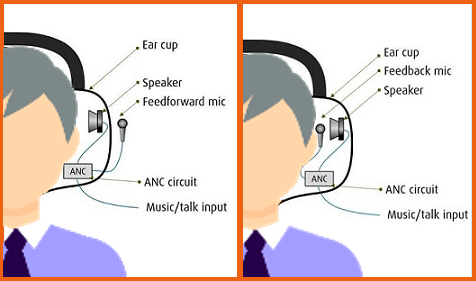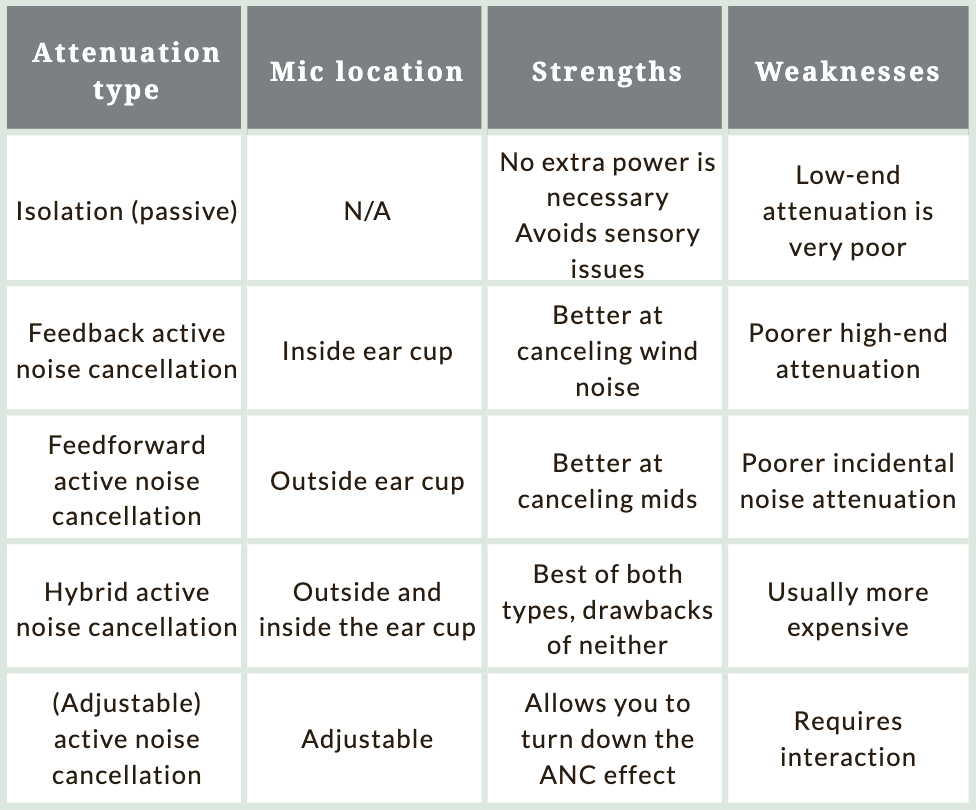With the rise of urbanization and technological advancements, noise pollution has become a prevalent issue in our modern society. However, technology has also provided us with solutions to tackle this problem. Two commonly used approaches are Active Noise Cancellation (ANC) technology, primarily used to clean the sound from the surrounding environment for hearing better (think headphones on airplanes), and AI-based noise cancellation algorithms, which excel at filtering noise from microphones (outbound stream) and headphones (inbound stream) for real-time communications. These two solutions differ significantly. ANC is directly perceived in the ear, while microphone noise canceling allows filtering out noise from the surrounding environment which passes through a microphone, enabling clear voice communications during calls or recordings.
ANC typically involves physical mechanisms to block or reduce external noises. These mechanisms can be found in various devices such as noise-canceling headphones, earplugs, and even architectural designs of buildings. They utilize microphones to capture external sounds and generate sound waves that are 180 degrees out of phase with the incoming noise, effectively canceling out the unwanted sounds.
It’s important to note that ANC often require specific hardware devices, while microphone noise-cancellation algorithms are software-based, making them adaptable to a variety of digital devices and applications. AI-based algorithms, in particular, are highly efficient, increasing their scalability and accessibility across different devices like wearables, smart speakers and smartphones.
On the other hand, AI-based microphone noise-cancellation algorithms leverage the power of artificial intelligence and machine learning to digitally analyze and process sound waves in real time, effectively removing noise from the stream. These algorithms are commonly used in software applications like voice assistants, video conferencing tools and audio editing software.
One key difference between ANC and AI-based noise-cancellation algorithms lies in the flexibility and adaptability they offer. ANC typically have a fixed design optimized for specific environments or types of noises. For example, active noise-canceling headphones excel at reducing low-frequency noises such as airplane engine sounds or traffic noises but may be less effective in canceling out higher-frequency noises like human voices or barking dogs.
In contrast, AI-based noise-cancellation algorithms are highly adaptable and can be continuously updated and optimized through learning processes. They can adjust to different types of noises and environments, making them more versatile and effective in reducing a wider range of noises. For instance, AI-based noise-cancellation algorithms in voice assistants can adapt to different accents, background noises, and speaking styles, ensuring clear and accurate voice recognition.
Another significant difference is the real-time processing capability of AI-based noise-cancellation algorithms, making them particularly valuable in applications where immediate noise reduction is crucial. In contrast, noise-cancellation (ANC) technologies may introduce a slight time delay in generating anti-noise signals.
Human and noise touchpoints
To better differentiate noise cancellation tools, it’s essential to understand the types of distortion that can affect a listener’s sound experience.
Noises are categorized into two types: noises from the real world directly reaching our ears from the surrounding environment and noises from virtual environments that reach our ears through additional devices, such as mobile phones or headphones during conference calls.
Noise from the real world
There are currently two types of headphone noise cancellation available, which can be used individually or in combination.
ANC has become a common feature in the headphone industry. However, not all ANC implementations are created equal. The quality of active noise cancellation varies based on differences in reference microphones and post-processing techniques.
In simple terms, active noise cancellation cancels out both frequencies, resulting in no audible signal. This works perfectly when both signals are identical except for one being inverted, leading to complete silence.
ANC systems utilize microphones, which can be divided into two categories: feedforward and feedback microphones.
Feedforward microphones are positioned on the outer part of the ear cups or earbuds and capture the sound waves before they enter the ear canal. They pick up environmental sounds and send them to the ANC processor, which produces a sound wave that is 180 degrees out of phase with the incoming sound, canceling it out.
Feedback microphones are positioned inside the ear cups or earbuds and capture sound that reaches the ear canal. They cancel out any sound waves that may have leaked through the seal of the ear cup or earbud. The ANC processor uses feedback microphones to adjust the sound wave produced by the feedforward microphones, enhancing the cancellation effect.

ANC systems can also utilize multiple microphones to further improve noise cancellation. For example, high-end ANC headphones may employ up to eight microphones, allowing for better distinction between desired and unwanted sounds, resulting in more accurate cancellation.
In summary, active noise cancellation systems rely on microphones to detect and cancel unwanted sounds. Multiple microphones enhance noise cancellation and provide a more enjoyable listening experience.
Here is a chart depicting different types of ANC microphones and their respective pros and cons:

Nowadays, ANC is not only used in headphones but also in cars and various home appliances. Vehicle systems capture noises using microphones or sensors placed at different parts of the car, such as acceleration and vibration sounds from the vehicle body. The captured noise is then processed by a Digital Signal Processor (DSP), which generates sound waves with opposite amplitudes to actively cancel out the noise.

Passive Noise Cancellation (Noise Isolation) is the simplest way to block noise that enters headphones from the surrounding world. It is the most widely used technology in headphone design due to its low cost. Passive cancellation techniques, also known as acoustic isolation systems, aim to prevent external sound from entering our auditory system. This is achieved by interposing insulating materials between the casing or external part of the earphone and the part attached to the ear.
Noise from virtual environments
Virtual environments are prone to background noise from various sources, including microphone feedback, background chatter, environmental sounds and audio artifacts from the virtual environment itself. These noises can disrupt the quality of virtual experiences, making it difficult for users to communicate effectively or fully immerse themselves in the virtual environment. However, advancements in artificial intelligence (AI) have opened up new possibilities for addressing this issue through AI-based noise cancellation technologies.
AI-based noise cancellation, such as Krisp’s Noise Cancellation, also referred to as AI-powered noise reduction or AI-enhanced noise suppression, utilizes AI algorithms to reduce or eliminate unwanted noise from audio signals in real time. Traditional noise cancellation methods may not be as effective in virtual environments due to the dynamic nature of virtual audio, which passes through networks and undergoes various filters and codecs. Virtual environments often involve multiple speakers with different types of microphones, sounds coming from different directions, and rapid changes.
Conclusion
In conclusion, both Active Noise Cancellation technologies and AI-based noise cancellation algorithms are effective solutions for tackling noise pollution. However, they differ in terms of flexibility, adaptability, real-time processing capabilities, and integration into different devices and applications. Having both solutions in place can make the workday more comfortable. As technology continues to evolve, we can expect further advancements in both approaches, providing us with more effective ways to reduce noise pollution and improve our quality of life.
Try next-level audio and voice technologies
Krisp licenses its SDKs to embed directly into applications and devices. Learn more about Krisp’s SDKs and begin your evaluation today.
References
- https://www.lifewire.com/measure-noise-cancelling-in-headphones-3134548
- https://www.listeninc.com/products/test-sequences/free/noise-cancelling-headphones-test-sequence/
- https://www.soundguys.com/noise-canceling-anc-explained-28344/
- https://www.etsi.org/deliver/etsi_ts/103600_103699/103640/01.01.01_60/ts_103640v010101p.pdf
- https://www.etsi.org/standards
- https://news.skhynix.com/anc-technology-your-everyday-life-evolution/
This article was written by Andranik Alajajyan, MSc in Nuclear Physics, Senior ML QA Engineer at Krisp.


